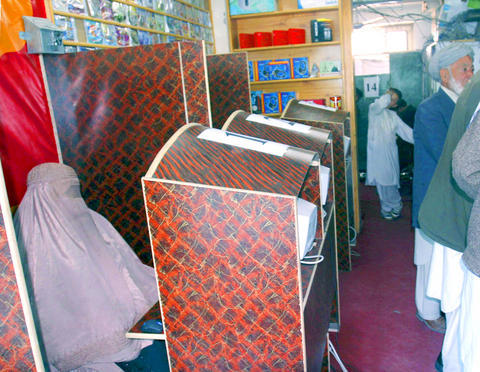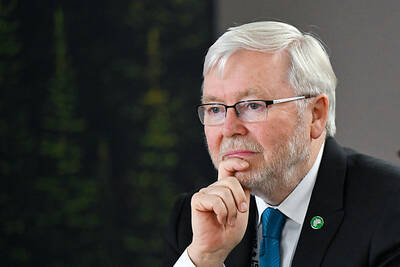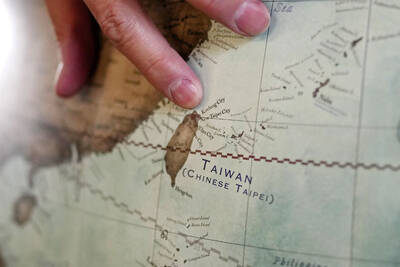In an Internet age, al-Qaeda prizes geek jihadis as much as would-be suicide bombers and gunmen. The terror network is recruiting computer-savvy technicians to produce sophisticated Web documentaries and multimedia products aimed at Muslim audiences in the US, Britain and other Western countries.
Already, the terror movement's al-Sahab production company is turning out high quality material, some of which rivals productions by Western media companies. The documentaries appear regularly on Islamist Web sites, which al-Qaeda uses to recruit followers and rally its supporters.
That requires people whose skills go beyond planting bombs and ambushing US patrols in Iraq and Afghanistan.

PHOTO: AP
"The al-Qaeda men who are coming today are not farmers, illiterate people," said Qari Mohammed Yusuf, an Afghan and self-declared al-Sahab cameraman. "They are PhDs, professors who know about this technology. Day by day they are coming. Al-Qaeda has asked them to come."
It was impossible to verify Yusuf's claim, although a former police chief in Yusuf's home province of Kunduz verified his links to al-Qaeda and the Taliban. Yusuf's information has proven reliable in the past.
Nevertheless, Western experts who monitor Islamist Web sites say the technical quality of al-Qaeda postings has dramatically increased from the grainy, amateurish images that were the hallmark of al-Sahab's work only a few years ago.
Now, postings are often in three languages -- Arabic, English and Urdu, the language of Pakistan where al-Qaeda hopes to draw fresh recruits. Videos look like professionally edited documentaries or television news broadcasts, with flashy graphics, maps in the background and split screens.
Footage lifted from Arab and Western television is often interlaced into the videos -- and al-Sahab appears to have a wide-ranging video library.
A speech by deputy al-Qaeda leader Ayman al-Zawahri issued to mark last year's anniversary of the Sept. 11, 2001, attacks included television interviews with wounded US soldiers, CIA analysts and talking-head journalists and experts, excerpts from a press conference by US President George W. Bush, audiotape of Malcolm X, even old World War II footage -- all edited in to back al-Zawahri's case that the US is losing the war on terror.
"What has changed dramatically is the quality, with documentaries and messages sometimes in three languages," said Rita Katz, director of SITE Intelligence Group, a US terrorism research center. "They are trying to outreach to as many people as possible."
Use of the Internet enables al-Qaeda to reach a broad global audience within the worldwide Muslim community rather than having to rely on Arabic language satellite stations, whose audiences are limited to the Middle East and who exercise some degree of editorial control.
"What is really amazing to me is watching how would-be terrorists living in the West are drawn in and captivated by al-Sahab videos," said Evan Kohlmann, a terror consultant for Globalterroralert.com.
Katz said the quality of some recent al-Sahab productions was "good enough to be on the Discovery Channel."
"We are not talking about people who don't know technology," she said. "They are very skilled. Al-Sahab must have a large team of people who have specific computer skills."
At the same time, the number of top quality al-Qaeda productions is on the rise.
According to the IntelCenter, a private US counterterrorism organization, al-Qaeda's propaganda wing produced and posted 74 video programs last year, an increase of 16 over 2006.
"It is clear that significant resources and efforts are being expended by al-Sahab to produce and release more videos than ever before and with consistently faster turnaround times than ever previously seen," IntelCenter said in a report last year.
Interviewed in a car with tinted windows as it swerved through colorful buses and ox-drawn carts, the bearded Yusuf outlined how al-Qaeda has jumped into the Internet age.
Instead of elaborate studios and equipment, the geek jihadis use laptops, generators and the right software to edit their material. For transmission, all they need is a high-speed Internet connection, which is available at scores of Internet cafes in towns and cities throughout Pakistan and Afghanistan.
Yusuf boasted that he once transmitted video from an Internet cafe across the street from the Afghan Ministry of Interior in Kabul.
Katz said producing propaganda videos for al-Sahab is a three-step process.
The first is to shoot the video. The second step -- the most time-consuming -- is to edit and produce the material, a process which requires skilled technicians but can be done in a simple mud hut anywhere in Afghanistan or the border area of Pakistan.
Once the material is ready, step three is transmitting through an Internet cafe.
"The al-Sahab man doesn't have to lug his computer on his back into the cafe," Katz said. "All he needs is a small USB stick and the high-speed Internet connection."
Al-Qaeda technicians have also become skilled at evading US detection techniques. Katz said they often use techniques such as "proxy servers" to disguise the point of origin.
"The al-Sahab people know and study technology, the latest law enforcement techniques," Katz said. "They know they can transfer files and they know not to transfer the entire file, to divide it into small pieces that eventually is stored in a single location."
Yusuf said al-Qaeda maintains its own cyberspace library, storing material in a secret server or servers so that the al-Sahab members do not have to keep incriminating material on their own laptops.
"There is a plan to make al-Sahab very big," Yusuf said. "It is part of the strategy. There are two parts. One is the fighting and the other part of the war is the media. We should carry out the media war because it inspires our people to come and fight."

NEXT GENERATION: The four plants in the Central Taiwan Science Park, designated Fab 25, would consist of four 1.4-nanometer wafer manufacturing plants, TSMC said Taiwan Semiconductor Manufacturing Co (TSMC, 台積電) plans to begin construction of four new plants later this year, with the aim to officially launch production of 2-nanometer semiconductor wafers by late 2028, Central Taiwan Science Park Bureau director-general Hsu Maw-shin (許茂新) said. Hsu made the announcement at an event on Friday evening celebrating the Central Taiwan Science Park’s 22nd anniversary. The second phase of the park’s expansion would commence with the initial construction of water detention ponds and other structures aimed at soil and water conservation, Hsu said. TSMC has officially leased the land, with the Central Taiwan Science Park having handed over the

AUKUS: The Australian Ambassador to the US said his country is working with the Pentagon and he is confident that submarine issues will be resolved Australian Ambassador to the US Kevin Rudd on Friday said that if Taiwan were to fall to China’s occupation, it would unleash China’s military capacities and capabilities more broadly. He also said his country is working with the Pentagon on the US Department of Defense’s review of the AUKUS submarine project and is confident that all issues raised will be resolved. Rudd, who served as Australian prime minister from 2007 to 2010 and for three months in 2013, made the remarks at the Aspen Security Forum in Colorado and stressed the longstanding US-Australia alliance and his close relationship with the US Undersecretary

‘WORLD WAR III’: Republican Representative Marjorie Taylor Greene said the aid would inflame tensions, but her amendment was rejected 421 votes against six The US House of Representatives on Friday passed the Department of Defense Appropriations Act for fiscal 2026, which includes US$500 million for Taiwan. The bill, which totals US$831.5 billion in discretionary spending, passed in a 221-209 vote. According to the bill, the funds for Taiwan would be administered by the US Defense Security Cooperation Agency and would remain available through Sept. 30, 2027, for the Taiwan Security Cooperation Initiative. The legislation authorizes the US Secretary of Defense, with the agreement of the US Secretary of State, to use the funds to assist Taiwan in procuring defense articles and services, and military training. Republican Representative

TAIWAN IS TAIWAN: US Representative Tom Tiffany said the amendment was not controversial, as ‘Taiwan is not — nor has it ever been — part of Communist China’ The US House of Representatives on Friday passed an amendment banning the US Department of Defense from creating, buying or displaying any map that shows Taiwan as part of the People’s Republic of China (PRC). The “Honest Maps” amendment was approved in a voice vote on Friday as part of the Department of Defense Appropriations Act for the 2026 fiscal year. The amendment prohibits using any funds from the act to create, buy or display maps that show Taiwan, Kinmen, Matsu, Penghu, Wuciou (烏坵), Green Island (綠島) or Orchid Island (Lanyu, 蘭嶼) as part of the PRC. The act includes US$831.5 billion in